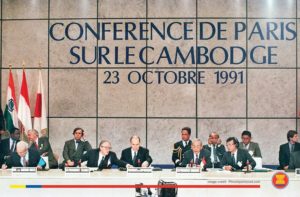October 23rd, 2021 – marked the 30th Anniversary of the Paris Peace Agreement for Cambodia. Many of our readers, especially the younger generation may not be familiar with what it is and what it means for Cambodia. Today, I will highlight the historical background that led to the 1991 Paris Peace Settlement and the reconstruction of Cambodia.
The 20 years of war between North Vietnam communists and South Vietnam (1955-1975) had a deep impact on Cambodia. In 1967, North Vietnamese forces intruded on Cambodian land by moving their war supplies and troops through the Ho Chi Minh Trail in eastern Cambodia to avoid bombing by American planes. For 14 months, America dropped bombs heavily in Cambodia to destroy North Vietnamese bases, but was unsuccessful. In the spring of 1970, Prince Sihanouk was removed from power and replaced by General Lon Nol. He joined large Cambodian demonstrations demanding that North Vietnamese and Viet Cong troops leave Cambodian land immediately. Instead, the North Vietnamese communists launched an attack on the Cambodian government. The Cambodia and Vietnam War started. The U.S. backed Lon Nol, who fought back the North Vietnamese. Prince Sihanouk went to Beijing for support and then joined with the Khmer Rouge. The Lon Nol government fell on April 17, 1975 to the Khmer Rouge; thirteen days after, North Vietnam took over South Vietnam.
Cambodia suffered a devastating loss of 2 million lives, in a country of 7 million, during the Khmer Rouge regime between 1975 to 1979. Many died from torture, execution, starvation and sickness. In turn, the Khmer Rouge fell on January 7, 1979, when Vietnam invaded Cambodia. Vietnam set up a new government in Cambodia with former Khmer Rouge leaders Heng Samrin and Hun Sen, but found itself engaged in continuous warfare in Cambodia for another decade.
In 1990, the world condemned Vietnam for invading Cambodia and sanctioned Vietnam economically, which crippled its economy. In addition, Vietnam lost its financial support for the war due to the collapse of Soviet Union, so it had to negotiate a peace settlement and withdraw its troops from Cambodia. Consequently, in 1991, Vietnam along with China and 17 other countries came together and signed the Paris Peace Agreement which ended the conflict in Cambodia. “The agreement was on the political settlement of the Cambodian conflict, sovereignty, territorial integrity and inviolability, neutrality and national unity of Cambodia, with a declaration on the rehabilitation and reconstruction of Cambodia.” Similar to South Korea, Cambodia was saved by the United Nations.
In 1992, as part of the rehabilitation for Cambodia, the United Nations Transitional Authority in Cambodia (UNTAC) sent over 15,000 troops, 3600 civilian police, 2000 civilians and 450 UN volunteers and thousands more local staff and interpreters to carry out its mission. UNTAC was to oversee military security and maintain law and order, control all aspects of the government, disarm Cambodia’s factions including the Khmer Rouge forces, supervise, monitor and verify the withdrawal and non-return of Vietnamese military forces, promote and protect human rights, repatriate all Cambodian refugees along the Thai border, and close all refugee camps. UNTAC also helped clear land mines and established training programs for mine clearance. This put the infrastructure in place for Cambodia and began its economic reconstruction and development.
In 1993, under UNTAC supervision, a national election was held for the first time since 1954. It was a hopeful time for the country as 89.5% of the population came out to vote. A 1995 UNTAC research report described its mission as “beginning the tortuous process of national reconciliation and giving the Cambodian people for the first time in almost 40 years the opportunity to choose their government in a comparatively free, fair and domestic manner. A new constitution was written, a new government formed, and an integrated national army was established.” It was viewed as a successful mission by UNTAC. It was the largest amount spent in the United Nations’ history to help a country, costing $1.6 billion.
30 Years Anniversary of 1991 Paris Peace Agreement: Where Cambodia is Today
Part I. National Elections

Read:



